
Despite acting as the research arm of Planned Parenthood for America (PPFA), the Guttmacher Institute has a reputation for putting out honest data. That reputation should change. Increasingly, Guttmacher’s need to protect Planned Parenthood, the nation’s largest abortion provider, is eroding its penchant for honest statistics.
Earlier this year, I wrote about how Guttmacher used an incredibly misleading statistic to grossly understate Planned Parenthood’s presence in poor, disproportionately black communities. I’ve also written extensively about how the market consolidation and subsequent lack of competition among women’s health-care providers that are accessible to poor women, coupled with a large payout for abortion, gives PPFA the incentive to provide substandard care to poor women. Since abortion provides Planned Parenthood more revenue after expenses than birth control does, it has reason to undersupply birth control so more women desire abortions.
As one piece of evidence for this, I noted that as Planned Parenthood’s market-share vastly increased in the 1990s, the number of unintended births among poor women spiked. This is where yet another Guttmacher data change recently arose.
Planned Parenthood’s Corporate Turnaround
First, some backstory. How did the increase in market share come about? A series of Harvard Business School case studies from 1997-98 focused on the challenges facing PPFA in 1994: “During the late 1970s and the early 1980s, PPFA, like many other healthcare providers, had experienced rapid growth, with annual revenues exploding from $80 million to over $400 million between 1978 and 1990… By the early 1990s, however, PPFA revenue growth had flattened, and beginning in 1992 the net margin had begun to decline.”
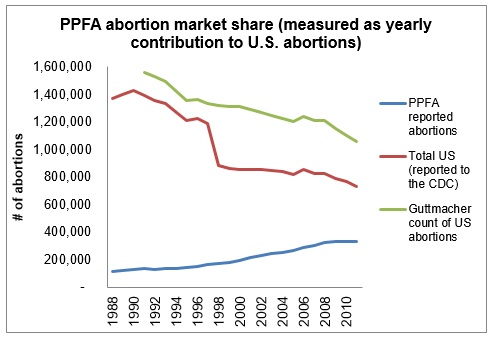
The Harvard study noted that much of the decline in margins and stagnation of revenues was due to the ascendance, at the time, of managed care and Medicaid managed care, which greatly affected PPFA, as its “clinics operated largely outside of the medical mainstream.”
Managed care did three things to PPFA: First, by increasing the pool of individuals with private insurance that covered reproductive health, managed care allowed many women to opt for care outside of Planned Parenthood. Second, by increasing competition for Medicaid patients because more providers could afford Medicaid reimbursement rates, managed care allowed a greater number of Medicaid recipients to get reproductive health care outside of Planned Parenthood. Lastly, by increasing the pool of uninsured persons, the number of PPFA customers who depended on highly subsidized contraception also increased.
Things were so bad that internal Planned Parenthood memos talked about the need for a “reinvention,” and worried that “affiliates will face bankruptcy within the next three years” if nothing was done.
In response, PPFA implemented a strategic realignment that finalized in 1997. The “reinvention process” included consolidating affiliates and moving to larger clinics (to harness greater economies of scale), a rebranding campaign, and increasing “financial incentives.”
At the same time, Planned Parenthood’s competitors were being driven out of the market. Abortion researcher Andrew Beauchamp has noted that increased state regulation, allowed by Planned Parenthood v. Casey (1992), began to drive smaller clinics specializing in reproductive health out of the market in the mid-1990s and set up barriers to entry that entrenched the surviving clinics (PPFA), and allowed the survivors (PPFA) to raise abortion prices.
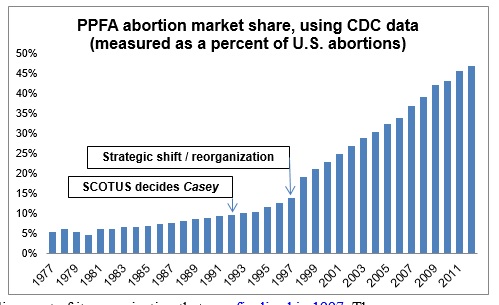
The result was a marked increase in PPFA’s market share, measured by abortions, and skyrocketing PPFA revenue, going from $400 million in 1990 to $1.3 billion today.
One of These Graphs Is Not Like the Other
PPFA had its turnaround, but the result for poor women wasn’t so good. They had little “choice” of contraception provider outside of a Planned Parenthood clinic. According to Amanda Marcotte, a left-wing blogger writing for the American Prospect, the average abortion patient used to be “[a] middle-class, white high-school or college student with no children whose bright future could be derailed by motherhood,” while today she is more likely “a twenty something single mother of color,” because of an unexplained “[l]oss of [birth control] access for poorer [minority] women” in the 1990s.
To back up this point, I’ve always used a graph (see below, left) from Guttmacher, which shows unintended pregnancy rates for poor American women dropping until 1994, then skyrocketing by the next time data was collected, in 2001.
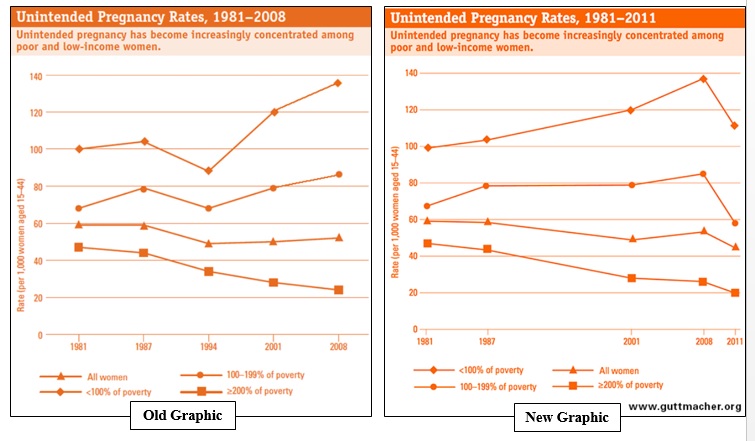
But when Guttmacher released its most recent report on unintended pregnancies in the United States, in early March 2016, the original graph appeared, plus a new data plot for 2011, but minus the data plot for 1994 (see graph above and to the right). According to Guttmacher’s text that accompanied the graph, “After rising for most of the 30-year period beginning in 1981, unintended pregnancy rates among poor women have recently begun to decrease [emphasis mine].”
This is important: that 1994 datapoint showed that unintended births among poor women were declining before Planned Parenthood or the intrauterine device (IUD) came along, but quickly reversed as PPFA’s market share and competitive position strengthened. Then, around April 2, 2016, the new “smoothed” graph was oddly removed from the main press release, and the URL was changed due to a website update:
The old URL: https://www.guttmacher.org/pubs/FB-Unintended-Pregnancy-US.html
The old URL’s “Wayback Machine” web archive: https://web.archive.org/web/*/https://www.guttmacher.org/pubs/FB-Unintended-Pregnancy-US.html
The new URL, first captured by the “Wayback Machine” on April 2, 2016, where the smoothed graph is taken out, replaced by a graphic of the United States that now appears twice, for no apparent reason: https://www.guttmacher.org/fact-sheet/unintended-pregnancy-united-states
After the website updates, the graph on the left turned into the graph on the right:
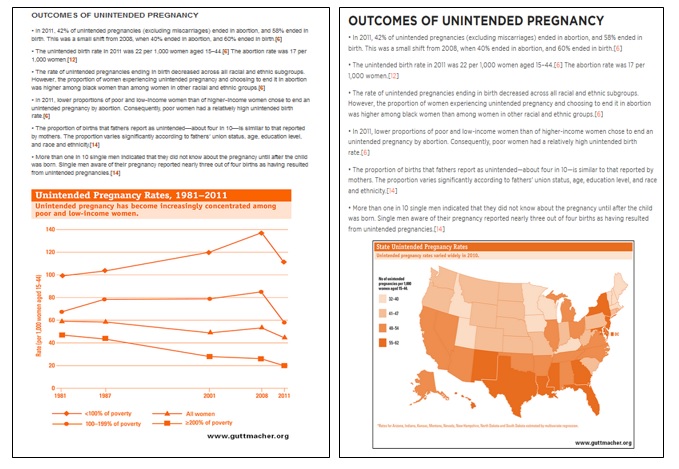
The smoothed graph is still available in the PDF fact sheet. It also appears—albeit in a version where the deletion of “1994” is less noticeable—on a page related to, but not linked to, the press release (see below).
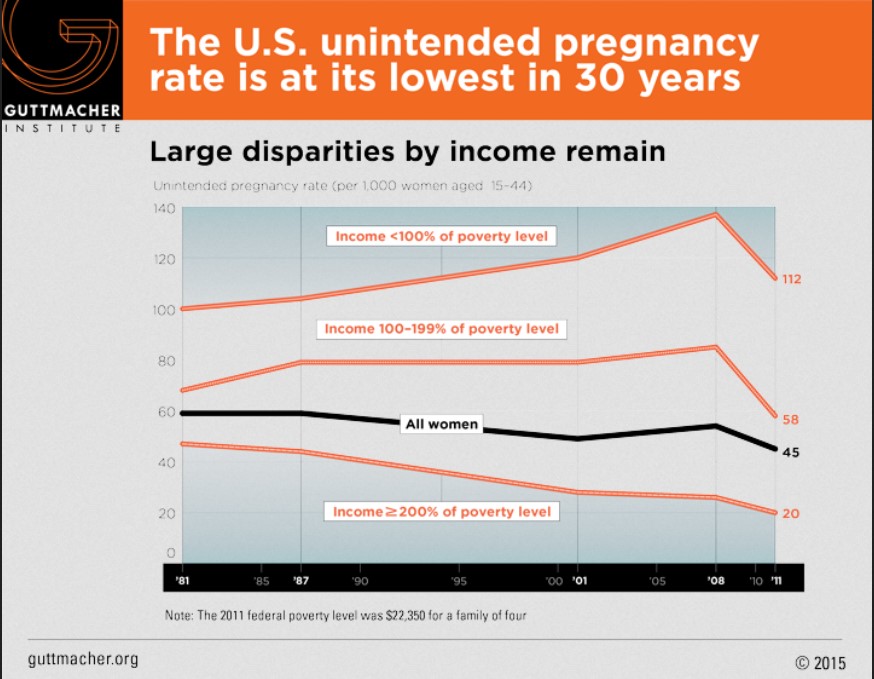
Starting on March 30, I called Guttmacher’s listed media contact on this press release to ask for a comment. I’ve called more than ten times since then, and left several messages, including on the media contact’s cell phone, and I’ve received no response. Either way, the damage is already done.
Lies, Damned Lies, and Statistics
At best, this is Guttmacher trying to further the false narrative that IUDs and Planned Parenthood are finally beating the tide of unintended pregnancies. At worst, this is Guttmacher trying to cover for PPFA, whose ascendancy corresponded with worse outcomes for the women it claims to serve.
Whatever the motivation, the media picked up the Guttmacher press release and ran with it, running stories claiming IUDs stopped an unstoppable trend. Outlets that ran the story include Medical Daily, Yahoo (via Mic), CNN, various regional newspapers, and (of course) Vox.
The truth is that unintended pregnancy rates were falling until the mid-’90s and then they suddenly shot up. Why did they shoot up? If IUDs are so great, why was the unintended pregnancy rate lower in the early ’90s, before IUDs were as widely used? If Planned Parenthood is so great, why was the unintended pregnancy rate lower in the early ’90s, before Planned Parenthood tripled its market share?
Guttmacher has put its need to protect Planned Parenthood and the “stories” the Left tells us about family planning above the truth. You can’t just delete a data point if it doesn’t fit your narrative. The pro-choice Left does this regularly, with statistics, history—a lot of things. There are lies, damned lies, and Guttmacher’s statistics.









